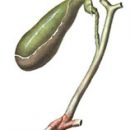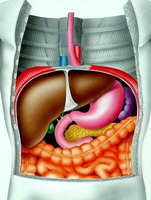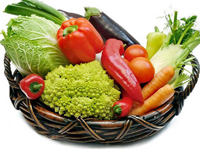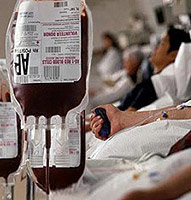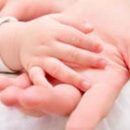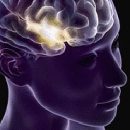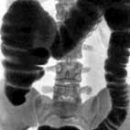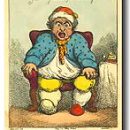Cholecystitis occupies one of the leading places among the diseases of the gastrointestinal tract. The predisposing factor in the development of the disease is the bile disease. The main symptoms of the disease are high temperature, chills, gravity in the right hypochondrium, belching.
Content
Cholecystitis - inflammatory disease of the gallbladder caused by hitting the organ of bacteria, viruses or having a parasitic nature.
Causes of cholecystitis
 Cholecystitis is considered one of the most excatient diseases of the digestive organs, which women most often suffer. Typically, the disease is developing against the background of gallway disease.
Cholecystitis is considered one of the most excatient diseases of the digestive organs, which women most often suffer. Typically, the disease is developing against the background of gallway disease.
The predisposing factors include:
- Diseases of the gastrointestinal tract
- Presence of parasites (Giardia, Askarid)
- gallbladder and liver injuries
- The presence of chronic infection foci
- Disorders of immune status
- Frequent constants
- irregular nutrition
- Frequent overeating
- sedentary lifestyle
- pregnancy
The causative agents of the disease in most cases are microbes (intestinal chopsticks, streptococci, enterococci, staphylococci), which fall into the gallbladder from the bowel on biliary ducts. The emergence and development of the disease contributes: gastritis (the secretory activity of the stomach), the gall-eyed disease is reduced (bile outflows violated), dyskinesia (violation of the motor activity of the gallbladder and biliary tract) and T.D.
Microbial contacts in the gallbladder can occur not only through the intestines, but also with blood flow or lymph.
Basic symptoms of the disease
By the nature of the course of the disease, acute and chronic cholecystitis distinguish.
Chronic cholecystitis divided into:
- Calculosis (with the formation of stones in the bustling bubble)
- Acalculse (without rock formation)
Under the inflammation of the gallbladder, the formation of stones indicates changes in the physicochemical properties of bubble bile, which occurred due to the chronic inflammatory process.
Acute form of the disease can develop after:
- Reception of bold dishes (as a rule in 2-4 hours)
- Physical Loads
- Stress
The first symptom of the disease is the pain that arises in the area of the right hypochondrium and gives to the poverty area, shoulder and right blade. Over time, the pain is becoming stronger.
Other symptoms:
- High body temperature (in severe cases up to 40 ° C)
- chills
- Owl of belly
- Severity under the flavor
- belching
- nausea, vomiting
- jaundice
Clinical blood test shows an increased number of leukocytes. The attack of acute cholecystitis can continue for several days, so it is better to immediately turn to the doctor when the first symptoms appear. Before the arrival of a specialist cannot be made any medicines or to use the heating plants, otherwise serious complications are possible.
Most often, the chronic form of the disease develops after acute. Often the disease proceeds against the background of other diseases of the gastrointestinal tract.
In the chronic form of the disease, it is observed:
- Dull pain in the right hypochondrium (arises after taking oily food)
- feeling of gravity in the upper stomach departments
- Sensation of bitterness in the mouth
- Owl of belly
- nausea
- belching
- constipation
In chronic cholecystitis, there is a disruption of digestion and suction of fats, which leads to the development of enteric insufficiency, dysbacteriosis, aggravation of chronic bowel diseases.
Treatment of cholecystitis
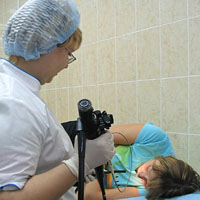 The treatment of cholecystitis begins with the use of drugs that facilitate the patient's condition, if they did not proper effect or were found stones in the bustling bubble, the patient prepare for operation.
The treatment of cholecystitis begins with the use of drugs that facilitate the patient's condition, if they did not proper effect or were found stones in the bustling bubble, the patient prepare for operation.
The treatment of cholecystitis is prescribed only after the necessary surveys. The following research methods are used to diagnose inflammation of the gallbladder:
- general blood analysis
- blood chemistry
- Analysis of duodenal content
- Abdominal ultrasound
- cholecystography
- thermography
- Fibrogastroduodenography
- Diagnostic laparoscopy
- Tomography and others.
With acute form of the disease, it is shown:
- Conducting disinfecting therapy
- The use of drugs overwhelming the secretion of the stomach
- The use of antibiotics and painkillers
- hunger
- Bed regime
In the chronic form of the disease, assign:
- Compliance with diet (fatty food completely excluded)
- Mineral water consumption
- Antibiotics of a wide spectrum and antispasmodics (during exacerbations)
- choleretic means (they stimulate the secretion of bile)
- Tools that increase the tone of the gallbladder
- Vitamin complex (group B), ascorbic acid, essential, Carsil
The treatment of cholecystitis (chronic) should be under the control of the doctor, all patients suffering from this disease, should be carried out preventive inspections 2 times a year.

